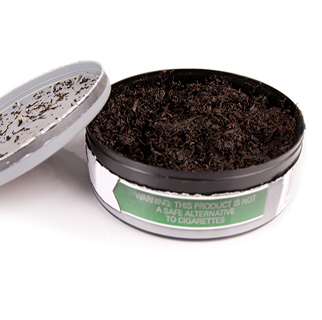Smokeless Tobacco

Many people think using smokeless tobacco is safer than smoking. But even though there is no smoke, that doesn't mean it's safe. Smokeless tobacco has very high levels of nicotine, much more than cigarettes. It's full of harmful chemicals. And it can cause many kinds of health problems.
What is smokeless tobacco?
Smokeless tobacco is a mixture of:
It is sold in 2 main forms:
-
Chew. Chew comes in 2 types. The first is the most popular and usually is simply called chew. This is a leafy form of tobacco. It's often sweetened with molasses or similar substances. It is sold in pouches. Users keep the chew between their cheek and gums for several hours at a time. The second type is called a plug. A plug is tobacco leaves that have been pressed into a brick. Users often bite off or cut a piece of the plug off and place it between the gum and cheek.
-
Snuff. Snuff comes in 2 types: moist and nasal (powdered). Moist snuff is often called dip. It's sold in a circular can called a tin. The tobacco is often flavored. Users place the tobacco between their lip and gum. This process is known as dipping. Dry snuff is meant to be breathed in. A user often places the powder on the back of their hand in a natural space that is called the snuff box. The user then snorts the powder up their nose. Using snuff also is called dipping.
High levels of nicotine
A person who uses smokeless tobacco gets 3 to 4 times the amount of nicotine as a smoker. A person who uses 8 to 10 dips or chews a day gets the same amount of nicotine as a heavy smoker who smokes 30 to 40 cigarettes a day.
Smokeless tobacco is addictive. The addiction is mostly caused by the nicotine. The nicotine in smokeless tobacco is absorbed by the body more slowly than in smoking. But it stays in the body longer. And chew tobacco placed inside the mouth gives the user a constant high from the nicotine.
Many harmful chemicals
The most harmful chemicals in smokeless tobacco are called tobacco-specific nitrosamines (TSNAs). These chemicals can cause cancer. TSNAs are formed as tobacco is grown, cured, fermented, and aged. The amount of these chemicals in smokeless tobacco can be very high.
Other harmful chemicals in smokeless tobacco include:
How it can affect health
Like cigarettes, smokeless tobacco affects the cardiovascular system. It can cause:
-
Heart disease
-
Stroke
-
High blood pressure
Smokeless tobacco can cause many mouth problems, such as:
-
Cracking and bleeding lips and gums
-
Precancer mouth sores called oral leukoplakia
-
Tooth abrasion
-
Receded gums
-
Gum and tooth disease
-
Loss of teeth and bone in the jaw
-
Long-term (chronic) bad breath
-
Teeth staining
Smokeless tobacco can also cause cancer. Cancer can happen in these areas:
-
Lips
-
Tongue
-
Cheek
-
Throat
-
Stomach
-
Esophagus
-
Pancreas
How to quit
Quitting smokeless tobacco is hard. But it can be done. To break the habit:
-
Talk with your healthcare provider. Ask them where you can get support in your effort to quit.
-
Ask about nicotine replacement. This includes products, such as nicotine gum or a patch.
-
Try using substitutes. Try tobacco-free mint-leaf snuff, sugarless gum, hard candy, beef jerky, sunflower seeds, shredded coconut, raisins, or other dried fruit.
-
Make a list of the reasons you want to quit. Keep it with you and look at it often.
-
Get involved in healthy activities. These may be things like lifting weights, shooting baskets, or swimming.
-
Manage your triggers. Find replacements for the things that make you want to use tobacco. Stay away from places or people that make you want to use it.
-
Reward yourself. Quitting is hard. Every day you don't use tobacco is a success!
-
Use free community resources. For some people, online and in-person support groups can help them stay away from tobacco. Some of these include:
Online Medical Reviewer:
Eric Perez MD
Online Medical Reviewer:
L Renee Watson MSN RN
Online Medical Reviewer:
Marianne Fraser MSN RN
Date Last Reviewed:
8/1/2023
© 2000-2025 The StayWell Company, LLC. All rights reserved. This information is not intended as a substitute for professional medical care. Always follow your healthcare professional's instructions.